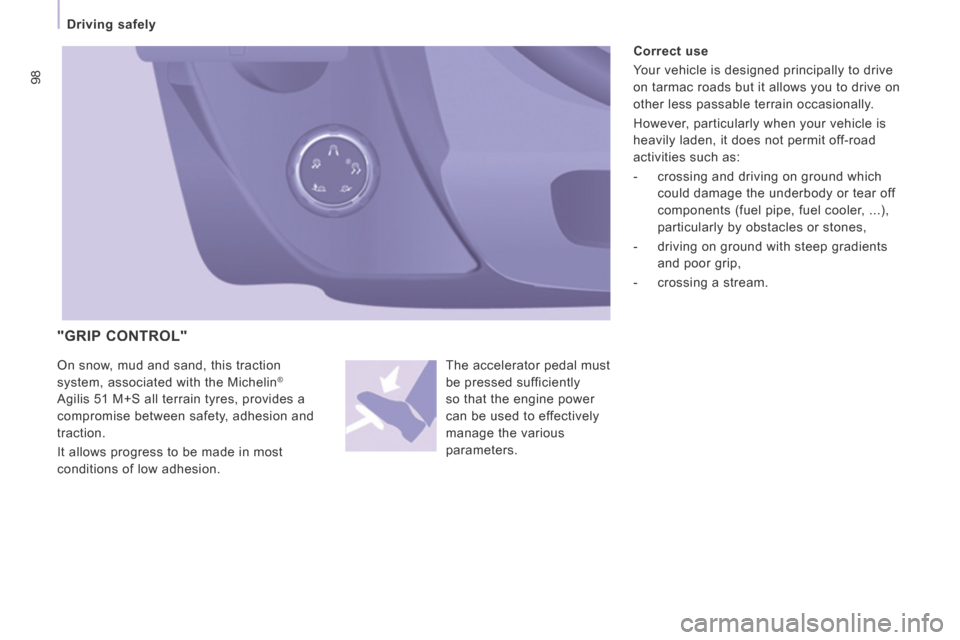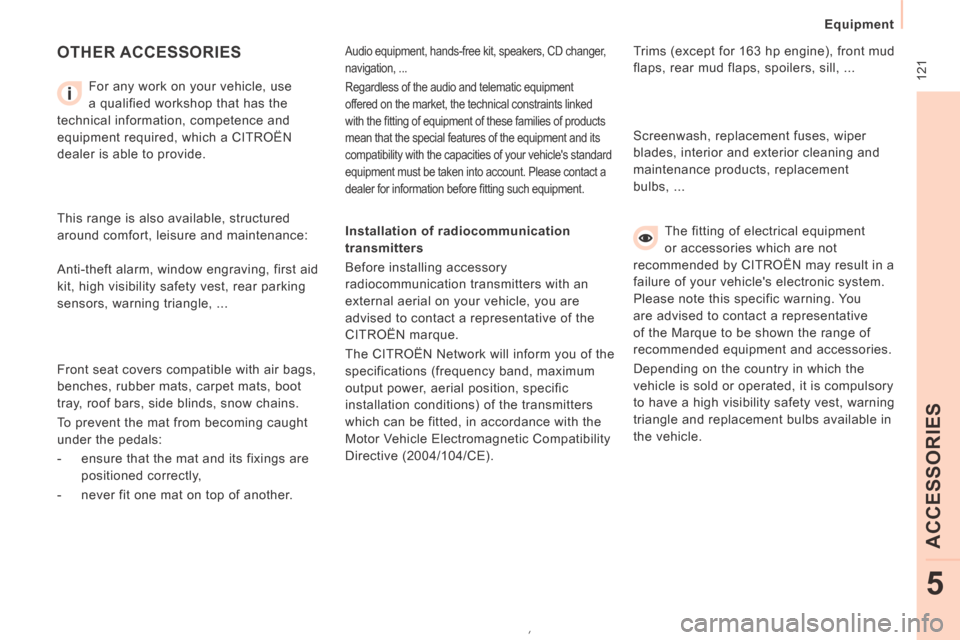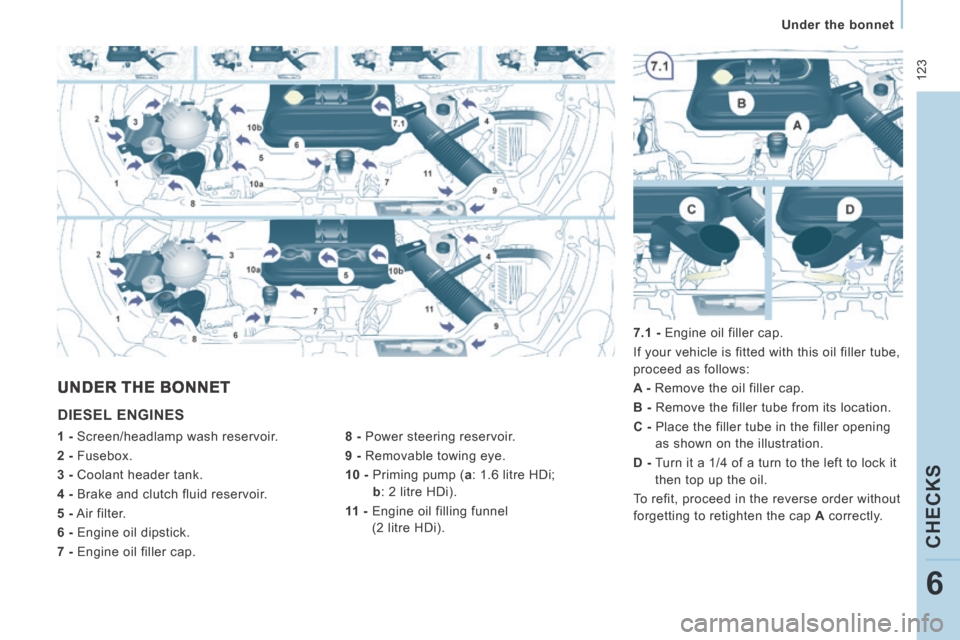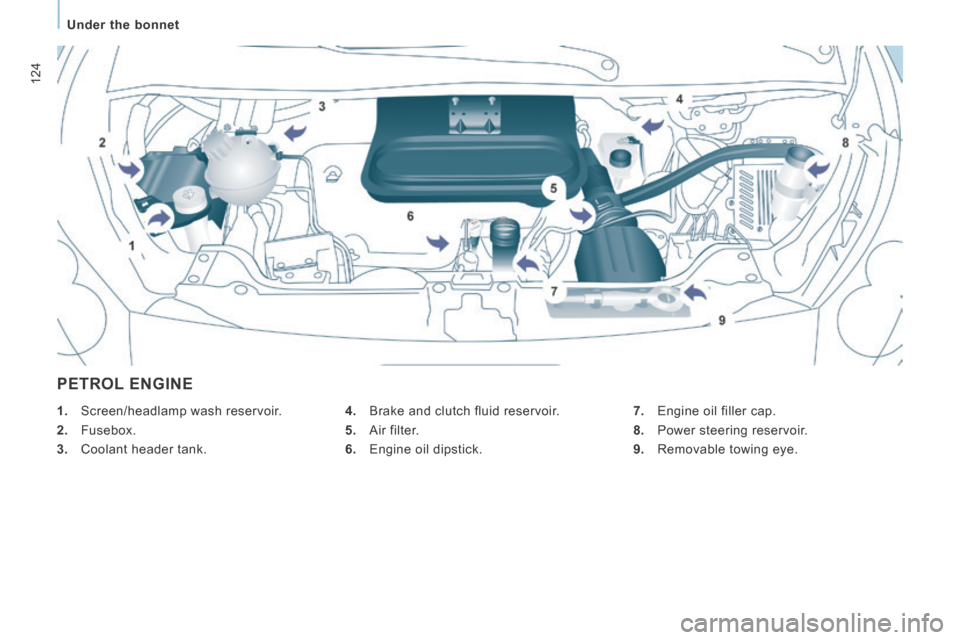engine Citroen JUMPY MULTISPACE 2014 2.G Owner's Guide
[x] Cancel search | Manufacturer: CITROEN, Model Year: 2014, Model line: JUMPY MULTISPACE, Model: Citroen JUMPY MULTISPACE 2014 2.GPages: 260, PDF Size: 13.41 MB
Page 66 of 260

64
Ventilation
JUMPY-ATLANTE-VP_EN_CHAP03_ERGONOMIE ET CONFORT_ED01-2014
Pressing this button, with the engine
running, activates the rapid demisting -
defrosting of the rear screen and/or electric
mirrors.
This function switches off:
- when the button is pressed,
- when the engine is switched off,
- automatically to prevent excessive energy consumption.
Demisting the rear screen and/or mirrors
Automatic air conditioning: visibility
programme
The comfort programme (AUTO) may not
be sufficient to quickly demist or defrost the
windows (humidity, several passengers, ice).
In this case, select the visibility programme.
The visibility programme indicator lamp
comes on.
It activates the air conditioning, the air
flow, the defrosting of the rear screen
and provides optimum distribution of the
ventilation to the windscreen and side
windows.
It deactivates the air recirculation.
Page 68 of 260

66
Ventilation
JUMPY-ATLANTE-VP_EN_CHAP03_ERGONOMIE ET CONFORT_ED01-2014
ADDITIONAL HEATING
Vehicles fitted with an HDi engine may be
fitted with a heater. When the engine is at
idle or the vehicle is stationary, it is normal
to notice a high-pitched whistling noise and
a slight emission of smoke and odour.
Rear ventilation
Coolant circuit heater
This is an additional and separate system
which heats the Diesel engine cooling
system to make starting easier.
It improves the demisting and defrosting
performance.
Page 99 of 260

OFF
97
Driving safely
SAFETY
4
JUMPY-ATLANTE-VP_EN_CHAP04_SECURITE_ED01-2014
ANTI-SLIP REGULATION (ASR) AND DYNAMIC STABILITY CONTROL (DSC)
These systems are linked and complement
the ABS.
The ASR system is very useful for
maintaining optimum drive and avoiding
losses of control of the vehicle on
acceleration.
The system optimises drive to prevent the
wheels skidding, by acting on the brakes of
the drive wheels and on the engine. It also
allows the directional stability of the vehicle
to be improved on acceleration. If there is a variation between the trajectory
followed by the vehicle and that required by
the driver, the DSC system automatically
acts on the engine and the brake of one
or more wheels, in order to put the vehicle
back on course. Deactivation
In certain exceptional conditions (starting
the vehicle when stuck in mud or snow, or
on loose ground...), it could prove useful
to deactivate the ASR and DSC systems to
make the wheels spin and regain grip.
Operating fault
Good practice
The ASR/DSC systems offer increased
safety during normal driving, but should not
encourage the driver to take risks or to drive
at high speed.
The operation of these systems is assured
only if the recommendations of the
manufacturer regarding the wheels (tyres
and rims), the braking components, the
electronic components and fitting and repair
procedures are observed.
After an impact, have these systems
checked by a CITROËN dealer or a qualified
workshop.
Operation
The warning lamp flashes when
operation of the ASR or DSC is
triggered.
They engage again:
- automatically above 30 mph (50 km/h),
- manually by pressing the button again. When a malfunction of the
systems occurs, the warning
lamp and the LED come on,
accompanied by an audible signal
and a message in the screen.
Contact a CITROËN dealer or a qualified
workshop to have the system checked.
The warning lamp may also come on if the
tyres are under-inflated. Check the pressure
of each tyre.
Use the DSC to hold your course without
attempting to countersteer. - Press the button, located on
the centre console.
- The LED comes on: the ASR and DSC systems no longer
operate.
Page 100 of 260

98
Driving safely
JUMPY-ATLANTE-VP_EN_CHAP04_SECURITE_ED01-2014
"GRIP CONTROL"
The accelerator pedal must
be pressed sufficiently
so that the engine power
can be used to effectively
manage the various
parameters.
On snow, mud and sand, this traction
system, associated with the Michelin ®
Agilis 51 M+S all terrain tyres, provides a
compromise between safety, adhesion and
traction.
It allows progress to be made in most
conditions of low adhesion. Correct use
Your vehicle is designed principally to drive
on tarmac roads but it allows you to drive on
other less passable terrain occasionally.
However, particularly when your vehicle is
heavily laden, it does not permit off-road
activities such as:
- crossing and driving on ground which
could damage the underbody or tear off
components (fuel pipe, fuel cooler, ...),
particularly by obstacles or stones,
- driving on ground with steep gradients and poor grip,
- crossing a stream.
Page 121 of 260

11 9
Towing a trailer
ACCESSORIES
5
JUMPY-ATLANTE-VP_EN_CHAP05_ACCESSOIRES_ED01-2014
For more information about weights,
refer to the administrative documents
(registration document, ...) or to the
"Weights" section of chapter 8.
TOWING A TRAILER, CARAVAN, BOAT, ETC...
Distribution of loads
Distribute the load in the trailer so that the
heaviest objects are as close as possible
to the axle and the nose weight is close to
the maximum authorised without, however,
exceeding it. Cooling
Towing a trailer on a slope increases the
coolant temperature.
As the fan is electrically controlled, its
cooling capacity is not dependent on the
engine speed.
Driving advice
A towed vehicle must free wheel: gearbox in
neutral.
Page 122 of 260

120
Towing a trailer
JUMPY-ATLANTE-VP_EN_CHAP05_ACCESSOIRES_ED01-2014
You should therefore use a high gear to
lower the engine speed and reduce your
speed.
In all cases, pay attention to the coolant
temperature. Tyres
Check the tyre pressures of the towing
vehicle (see the "Identification markings"
section of chapter 8) and of the trailer,
observing the recommended pressures. Towbar
We recommend the use of genuine
CITROËN towbars and their harnesses,
which have been tested and approved from
the design stage of your vehicle, and that
you entrust the fitting of this equipment to a
CITROËN dealer.
If this equipment is not fitted by a CITROËN
dealer, it is imperative that it is fitted using
the electrical pre-equipment installed at the
rear of the vehicle and in accordance with
the manufacturer's instructions.
In accordance with the general instructions
a reminder of which has been given above,
we draw your attention to the risk associated
with fitting a towbar or electrical accessory
not recommended by CITROËN. Fitting such
equipment could result in the failure of your
vehicle's electronic system. Please obtain
information from the Manufacturer before
fitting this type of equipment.
If the coolant temperature warning
lamp comes on, stop the vehicle
and switch off the engine as soon
as possible.
Good Practice
In certain cases of particularly arduous
use (towing the maximum load up a steep
slope in high temperatures), the engine
automatically limits its power. In this case,
the air conditioning is automatically cut off to
save engine power.
See the "Levels" section of chapter 6. Brakes
Towing increases the braking distance. Drive
at a moderate speed, change down early
and brake gradually.
Side wind
Sensitivity to side wind is increased. Drive
smoothly and at a moderate speed.
ABS/DSC
The ABS or DSC systems only control the
vehicle, not the trailer or caravan.
Rear parking sensors
The parking sensors system does not
function while the vehicle is towing.
Page 123 of 260

121
Equipment
ACCESSORIES
5
JUMPY-ATLANTE-VP_EN_CHAP05_ACCESSOIRES_ED01-2014
OTHER ACCESSORIES
For any work on your vehicle, use
a qualified workshop that has the
technical information, competence and
equipment required, which a CITROËN
dealer is able to provide.
Installation of radiocommunication
transmitters
Before installing accessory
radiocommunication transmitters with an
external aerial on your vehicle, you are
advised to contact a representative of the
CITROËN marque.
The CITROËN Network will inform you of the
specifications (frequency band, maximum
output power, aerial position, specific
installation conditions) of the transmitters
which can be fitted, in accordance with the
Motor Vehicle Electromagnetic Compatibility
Directive (2004/104/CE).
This range is also available, structured
around comfort, leisure and maintenance:
Trims (except for 163 hp engine), front mud
flaps, rear mud flaps, spoilers, sill, ...
Audio equipment, hands-free kit, speakers, CD changer,
navigation, ...
Regardless of the audio and telematic equipment
offered on the market, the technical constraints linked
with the fi tting of equipment of these families of products
mean that the special features of the equipment and its
compatibility with the capacities of your vehicle's standard
equipment must be taken into account. Please contact a
dealer for information before fi tting such equipment.
Front seat covers compatible with air bags,
benches, rubber mats, carpet mats, boot
tray, roof bars, side blinds, snow chains.
To prevent the mat from becoming caught
under the pedals:
- ensure that the mat and its fixings are
positioned correctly,
- never fit one mat on top of another. Screenwash, replacement fuses, wiper
blades, interior and exterior cleaning and
maintenance products, replacement
bulbs, ...
The fitting of electrical equipment
or accessories which are not
recommended by CITROËN may result in a
failure of your vehicle's electronic system.
Please note this specific warning. You
are advised to contact a representative
of the Marque to be shown the range of
recommended equipment and accessories.
Depending on the country in which the
vehicle is sold or operated, it is compulsory
to have a high visibility safety vest, warning
triangle and replacement bulbs available in
the vehicle.
Anti-theft alarm, window engraving, first aid
kit, high visibility safety vest, rear parking
sensors, warning triangle, ...
Page 124 of 260

122
Opening the bonnet
JUMPY-ATLANTE-VP_EN_CHAP06_VERIFICATIONS_ED01-2014
OPENING THE BONNET
From inside:
- lift the cover located at the foot of the front left seat.
- pull the release lever upwards. To close
Lower the bonnet and release it at the end of its
travel. Check that the bonnet is properly latched.
From outside: partially open the bonnet, lift
the safety catch and raise the bonnet.
Bonnet stay
Secure the stay in one of the two notches,
according to the height required, to hold the
bonnet open.
Before closing the bonnet, replace the stay
in its housing. "Bonnet open" warning
This warning is linked to the
alarm option
only.
With the engine running or the
vehicle moving, a warning lamp
and a diagram in the screen,
accompanied by an audible
signal, warn you that the bonnet
is not properly closed.
Page 125 of 260

123
Under the bonnet
CHECKS
6
JUMPY-ATLANTE-VP_EN_CHAP06_VERIFICATIONS_ED01-2014
DIESEL ENGINES
8 - Power steering reservoir.
9 - Removable towing eye.
10 - Priming pump ( a : 1.6 litre HDi;
b : 2 litre HDi).
11 - Engine oil filling funnel
(2 litre HDi).
UNDER THE BONNET
1 - Screen/headlamp wash reservoir.
2 - Fusebox.
3 - Coolant header tank.
4 - Brake and clutch fluid reservoir.
5 - Air filter.
6 - Engine oil dipstick.
7 - Engine oil filler cap. 7.1 - Engine oil filler cap.
If your vehicle is fitted with this oil filler tube,
proceed as follows:
A -
Remove the oil filler cap.
B - Remove the filler tube from its location.
C - Place the filler tube in the filler opening as shown on the illustration.
D - Turn it a 1/4 of a turn to the left to lock it then top up the oil.
To refit, proceed in the reverse order without
forgetting to retighten the cap A correctly.
Page 126 of 260

124
Under the bonnet
JUMPY-ATLANTE-VP_EN_CHAP06_VERIFICATIONS_ED01-2014
PETROL ENGINE
4. Brake and clutch fluid reservoir.
5. Air filter.
6. Engine oil dipstick.
1. Screen/headlamp wash reservoir.
2. Fusebox.
3. Coolant header tank. 7. Engine oil filler cap.
8. Power steering reservoir.
9. Removable towing eye.